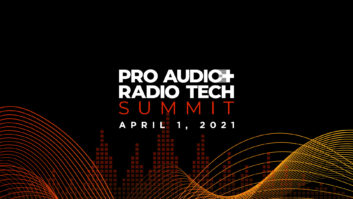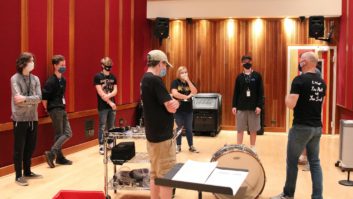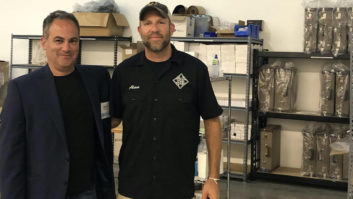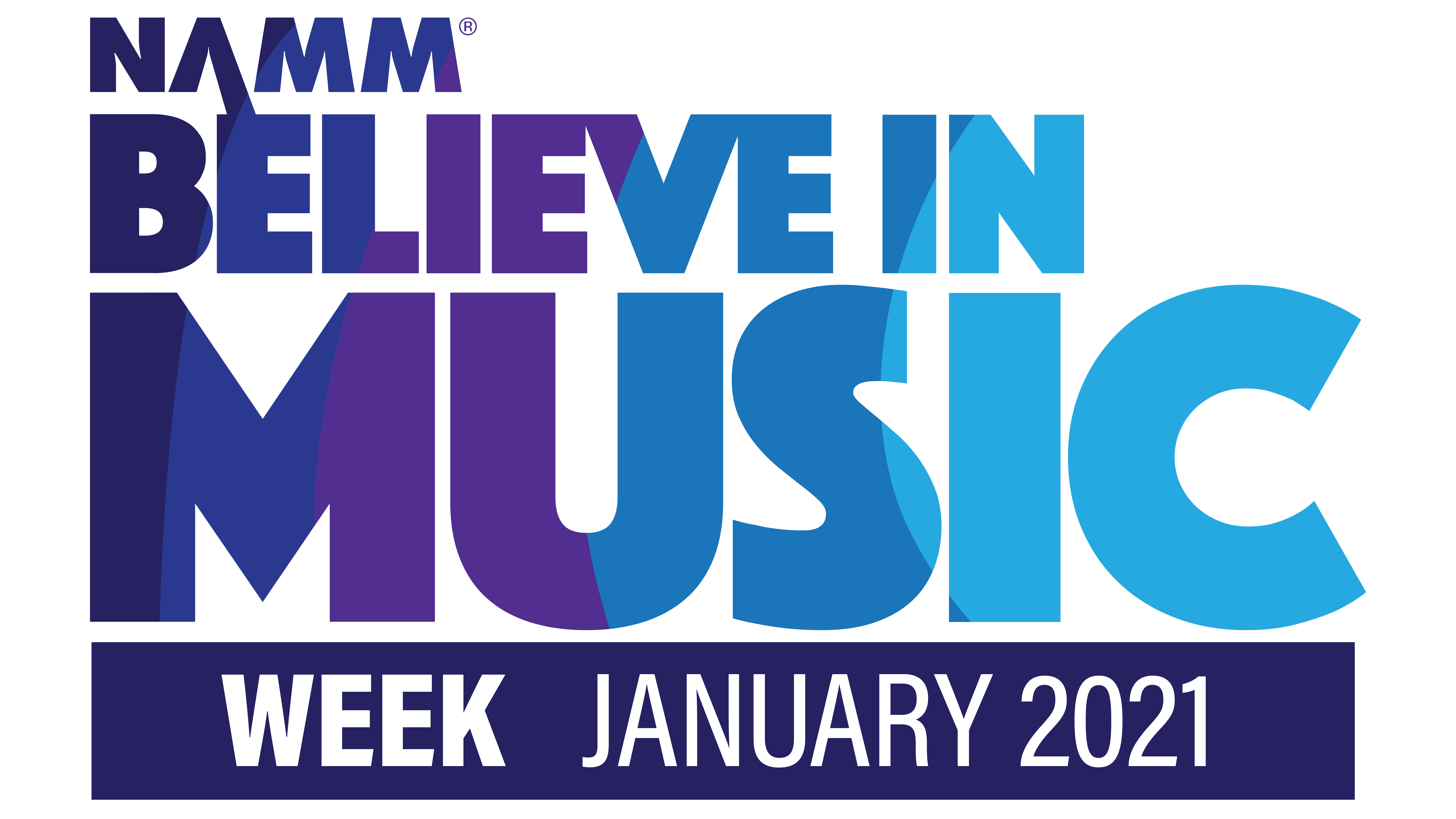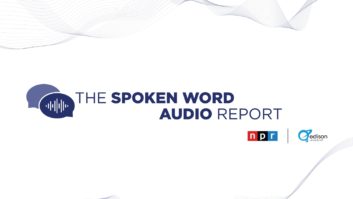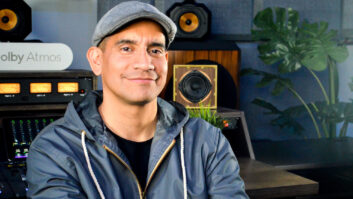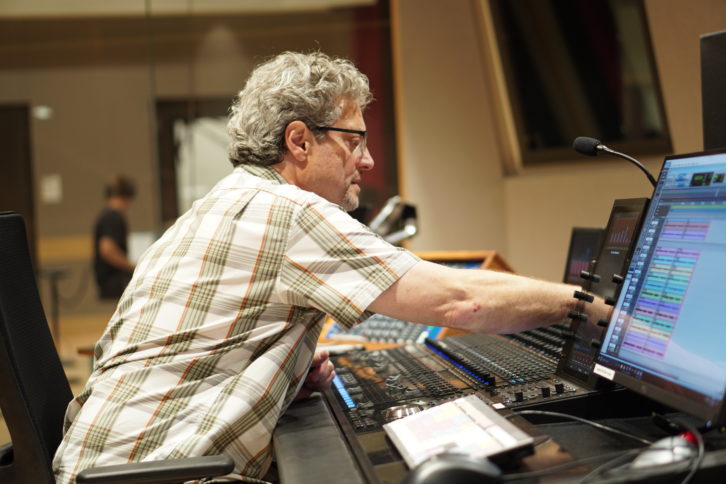
I’ve been teaching audio since 1989, and I’d like to think that I’m reasonably good at it, but a few weeks ago, everything I thought I knew about audio education went out the window. The COVID-19 pandemic changed virtually every aspect of life, whether it’s shopping for groceries, traveling, “visiting” our families, or even walking on the street. Some areas of life are being impacted more profoundly than others, and education is definitely one of them.
Online education is nothing new, so it’s easy to say “just move classes online,” but the fact is that online education translates more effectively with some disciplines than it does with others—and for some institutions, audio is definitely not one of them. Audio educators face a multitude of issues, such as ensuring that students have the tools they need to continue learning, maintaining consistent references, delivering high-quality audio via streaming, demonstrating hands-on techniques and keeping students from going AWOL.
Some institutions were able to shift gears to online instruction more easily than others. As an example, the Music Production bachelor’s program at Full Sail University (Winter Park, Fla.) started as an online-only program 10 years ago, so resources were already in place for shifting on-campus students to online classes.
In contrast, the Conservatory of Recording Arts and Sciences (Tempe, Ariz.) put their program on pause, electing to not move classes online—though they have made multiple efforts to keep students involved in the program. Other programs modified their course sequencing to maximize available resources, or modified course curriculum so that it could be taught online.
Audio programs are carrying on, but it is definitely not business as usual.
Let’s Get Engaged
Keeping students engaged in online learning—especially when it’s not what they signed on for—can be a difficult task. “The idea of converting our program to an entirely online model doesn’t really fit our mindset,” begins Robert Brock, Director of Education, CRAS. “Our hallmark has always been hands-on instruction, so the big challenge for us is redefining our program so that it still meets the objective goals of a hands-on program, while continuing to operate and educate under these new conditions.
“When the shut-down came into effect, the Conservatory reached out to the faculty and asked them to keep students engaged so that when this is over, their heads will still be in it,” he continues. “We created high-resolution graphics of all of our analog console surfaces, and created ways that students could see specific patch bays. We recorded instructors going through reviews in our control rooms, which helps students visually stay in touch with the studios that they were using.
“We also reached out to a lot of engineers and graduates, and found that they were readily available for Zoom sessions due to the current conditions. Many of our students went home to be with their families during this time, but they were able to continue their education outside of our core program with these additional opportunities. And since we’ve been able to record that material, it’s valuable ‘library footage’ that we can use in the future.”
Manufacturers Step Up
“The support we, and I’m sure other institutions, are receiving from software and hardware manufacturers has been really helpful in keeping students involved,” reveals Konrad Strauss, Professor of Music and Chair, Department of Audio Engineering and Sound Production, Indiana University Jacobs School of Music (Bloomington, Ind.). “iZotope provided 60-day licenses for Ozone 9 and iZotope RX for all of the students taking a course in media and mastering preparation so they could continue work using those particular tools. They also offered the Exponential Audio Phoenixverb reverb plug-in for another course that I teach in classical music recording, so students had a good reverb for their classical music mixes. Sonarworks offered free 60-day licenses for Reference 4 Headphone Edition, which enabled students to have acoustic modeling for their headphones to help make their mixes more accurate.”
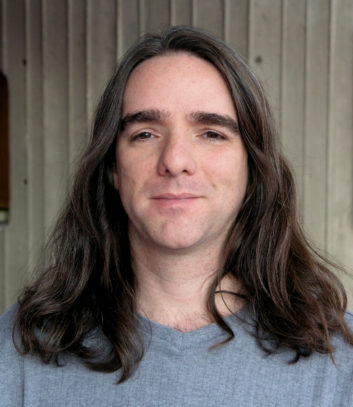
Strauss’ colleagues Michael Stucker (Associate Professor of Music, Audio Engineering and Sound Production) and Jacob Belser (Lecturer in Music, Audio Engineering and Sound Production) were in the midst of teaching classes in advanced studio recording when the pandemic hit. As Stucker describes it, “The students were very disappointed when they were told they wouldn’t be able to use the studios. We struggled with ideas on what to do, and then the leader of one of the school jazz bands offered to help. The jazz band had a brand new chart that they’d rehearsed but hadn’t yet recorded, so we made it a project to record the band members playing that chart individually in their homes, with our students mentoring the jazz band students. Avid provided Pro Tools Ultimate trial licenses for our students and for some of the musicians, and other musicians used Pro Tools Free. Focusrite donated the use of Scarlett 2i2 interfaces, and Lewitt donated LCT 240 and LCT 440 large-diaphragm microphones, which we shipped out to the musicians. Our students had to help the musicians—many of whom didn’t know anything about Pro Tools—get Pro Tools installed and working. They then worked with the musicians to set up their space, determine microphone placement to get a good sound, and record their tracks.
“The composer (who was one of the band members) provided a MIDI version of the track as a guide,” Stucker adds. “That went first to the bass player in Australia, then to the piano player in Tokyo and then to the drummer, giving us a rhythm section. From there they proceeded to record other instruments. We initially used Avid Cloud for the file sharing, but there are limits to how many people can share a session, and it wasn’t as many as we needed. One student was put in charge of how sessions were exchanged, and they had to solve issues with tracks that didn’t get bounced or aligned properly. We mentored, but it was on the students to figure out how the file management worked. It was a real-world situation.”
“It’s really been great to watch the imaginative ways in which our faculty has adapted,” notes Brian Smithers, Program Director, Audio Production, Full Sail University. “Using the knowledge and experience we gained from delivering online education for over a decade, we were uniquely positioned to make the transition online. One of our instructors set up a Yamaha audio console in a room on campus, put up an overhead camera and holds regular office hours there. Students call in using Zoom during his office hours, and they can ask questions like, ‘I’ve set this up in the offline editor and I think I understand how the channel strip works, but can you actually walk me through this process so that I’m sure I’m getting it right?’ That brings a student as close as possible to having their hands on the console.
“A few of the instructors produced a video walkthrough of building a direct box, and that can be used in a live Zoom class where the instructor turns off the narration and takes the students through the process,” he adds. “Students who can’t attend the lecture can access the video with its original narration.”
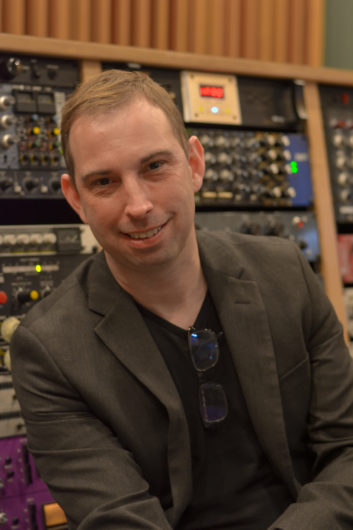
Scott Wynne, Professor & Chief Recording Engineer, Hayes School of Music, Appalachian State University (Boone, N.C.), took advantage of the large number of student musicians at his institution.
“As soon as it looked like the students weren’t coming back from spring break, I sent out a link to a Google Sheets document, asking all of the students in my program to list what hardware and software they had, what instruments they could access, and their level of ability to perform on those instruments. It was a way to keep them in touch, as well as to gather information.
“My juniors were supposed to record an artist in the studio, so we expanded that idea based on available resources,” Wynne continues. “Let’s suppose they were looking for a jazz guitarist who had a semi-hollow body guitar and a Fender Deluxe Reverb. They could reference the sheet and see which students might have a combination close to that, and what their ability was to record on their own. From there they collaborated remotely using Google Drive by zipping up a Pro Tools session and sending it over to the musician. That student would download the session, add their part and send it back. It enabled them to experience the online collaboration that we see so often in the industry.”
Do You Hear What I Hear?
Providing a level playing field for students who are working on their own is difficult at best.
When students and an instructor are listening to the same speakers in the same control room, there is a common reference for sonic assessments, but how can you critique a mix when you don’t know what a student is hearing?
Full Sail University has long implemented its Project LaunchBox, a package given to each student that includes a MacBook Pro, an audio interface, software, a microphone and headphones. It provides instructors with the ability to plan classes and assignments knowing that every student has access to the same “baseline” tools.
“The Audio Production bachelor’s degree program is online-only,” Smithers elaborates, “and we felt it was important for those students to have speakers, as well, so their LaunchBox includes a pair of PreSonus Eris 5 monitors. We have a number of pairs of Eris 5s for faculty, so an instructor who teaches Advanced Mixing Techniques can hear exactly what the students are hearing.”
At CRAS, a similar approach is taken. “On day one,” states Brock “every student is issued a MacBook Pro, an audio interface, a Blue Spark microphone, a mic cable, software and Blue headphones. Essentially, every student has a lab on their laptop, which enables them to have hands-on time even when they are not using our facilities.”
Another tool helpful in the battle against inconsistent monitoring environments was furnished by Sonarworks, which has been working closely with educational institutions to provide extended trial licenses for the Reference 4 Headphone Edition.
“Most of our students already have professional-quality headphones.” reports Wynne, “but they have to go through that learning curve of realizing that their headphones are not flat, and that they need to listen on different headphones to check different aspects of their mixes. Listening to reference tracks with and without Reference 4 helps them understand how their headphones influence their mixing decisions.”
An almost universal problem facing online learning is the poor (to be polite) audio quality of most video conferencing platforms. My initial use of Zoom to conduct a class on effects processing was fraught with issues ranging from poor frequency response to serious side effects from the Zoom codec.
“The audio quality on Zoom is pretty horrendous.” agrees Strauss. “We started using a plug-in called Listento made by Audiomovers that can be instantiated on a workstation, and will stream high-quality audio to a web link. When I was mentoring the students in my classical music recording class, we used Listento so that I could hear their mixes with high-quality audio, and that allowed me to make judgments about timbre, ambience and mix.”
Making the Grade
When the COVID-19 shutdown forced classroom students online, many institutions had to modify their thinking in regards to student feedback and grading, which was the right thing to do in light of the disruption foisted upon on-campus students. Some institutions offered the option of a pass/fail grade. At Mercy College (Dobbs Ferry, N.Y.), we allowed students a CE/NE grading option, whereby a student earning a grade of D or higher would receive Credit Earned, while a grade of F would result in No Credit Earned. In either case, the grade was not counted toward the student’s GPA.
According to Wynne, “Appalachian State had a very liberal grading policy whereby a student could choose to drop a course after grades were submitted—even if they had failed the class. They also could opt for certain classes to be graded as pass or fail, so a 65 or better would earn them a passing grade and wouldn’t affect their GPA. The university tried to be as understanding as possible in regards to how this situation might negatively impact the student’s GPA and their ability to pursue grad school.”
Brock doesn’t envision CRAS “lowering or shifting our expectations as far as what somebody needs to do in order to successfully complete our program. If a student was supposed to have a timed, hands-on proficiency exam in a particular room, they’re still going to have to demonstrate that knowledge.

